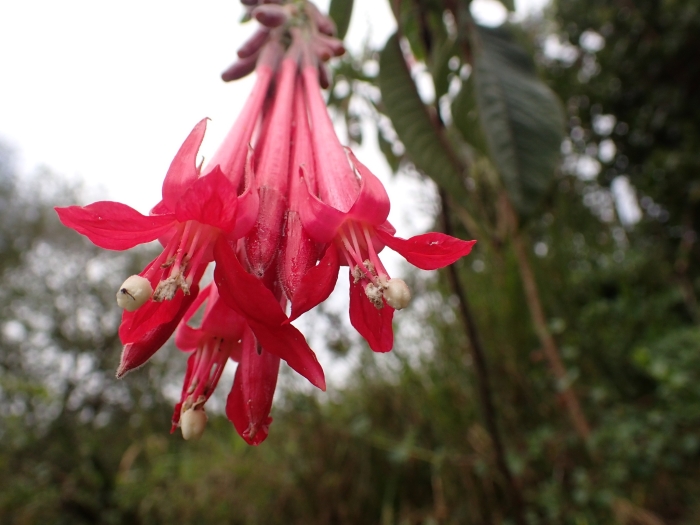Bolivian Fuchsia
(Fuchsia boliviana)
Bolivian Fuchsia (Fuchsia boliviana)
/
/

agujaceratops
CC BY 4.0
Image By:
agujaceratops
Recorded By:
Copyright:
CC BY 4.0
Copyright Notice:
Photo by: agujaceratops | License Type: CC BY 4.0 | License URL: http://creativecommons.org/licenses/by/4.0/ | Rights Holder: agujaceratops | Publisher: iNaturalist | Date Created: 2023-08-22T14:57:56-07:00 |
























Estimated Native Range
Summary
Fuchsia boliviana, commonly known as Bolivian Fuchsia, is an evergreen shrub native to the cool, moist montane forests and cloud forests in the Andes of southern Peru, Bolivia, and northern Argentina. It typically grows to a height of 7-13 feet (2-4 meters) and is characterized by its large, hairy, mid-green leaves with distinctly red petioles. The plant produces drooping clusters of scarlet red tubular flowers with long, protruding stamens that bloom in late summer and autumn, attracting hummingbirds and other pollinators. The flowers are quite showy and can add a splash of color to shady garden areas. After flowering, it bears small, edible red-purple fruits that are enjoyed by local wildlife.
Bolivian Fuchsia is valued for its ornamental flowers and is often used in cooler, subtropical climates for border planting, as a specimen in shaded gardens, or in containers. It requires protection from direct sunlight and high temperatures, preferring part shade to full shade conditions. The plant thrives in moist, well-drained soils with high organic content and benefits from regular watering, especially during dry periods. While it can tolerate brief cold spells, it is not frost-hardy and should be protected or moved indoors in regions with harsh winters. The white-flowering form ’Alba’ offers an alternative to the typical scarlet flowers. Propagation is commonly achieved through seed or cuttings. Potential problems include fuchsia rust, mites, and whiteflies, particularly when grown in greenhouse conditions.CC BY-SA 4.0
Bolivian Fuchsia is valued for its ornamental flowers and is often used in cooler, subtropical climates for border planting, as a specimen in shaded gardens, or in containers. It requires protection from direct sunlight and high temperatures, preferring part shade to full shade conditions. The plant thrives in moist, well-drained soils with high organic content and benefits from regular watering, especially during dry periods. While it can tolerate brief cold spells, it is not frost-hardy and should be protected or moved indoors in regions with harsh winters. The white-flowering form ’Alba’ offers an alternative to the typical scarlet flowers. Propagation is commonly achieved through seed or cuttings. Potential problems include fuchsia rust, mites, and whiteflies, particularly when grown in greenhouse conditions.CC BY-SA 4.0
Plant Description
- Plant Type: Shrub
- Height: 4-10 feet
- Width: 3-5 feet
- Growth Rate: Moderate
- Flower Color: Pink, Red, White
- Flowering Season: Summer, Fall
- Leaf Retention: Deciduous, Semi-deciduous
Growth Requirements
- Sun: Full Shade
- Water: Medium
- Drainage: Medium
Common Uses
Bird Garden, Border Plant, Butterfly Garden, Hummingbird Garden, Potted Plant, Showy Flowers
Natural Habitat
Cool, moist montane forests and cloud forests
Other Names
Common Names: Earring Flower, Fuchsia, Fuchsia De Bolivie, Fuchsia À Grande Feuille, Lady’s Eardrops
Scientific Names: , Fuchsia boliviana, Fuchsia boliviana f. puberulenta, Fuchsia boliviana var. luxurians, Fuchsia boliviana var. typica, Fuchsia cuspidata, Fuchsia lenneana, Fuchsia lenneana,
GBIF Accepted Name: